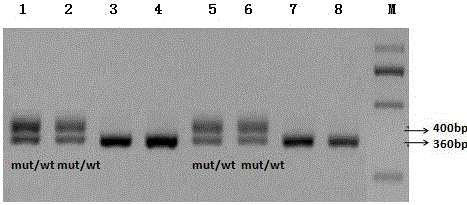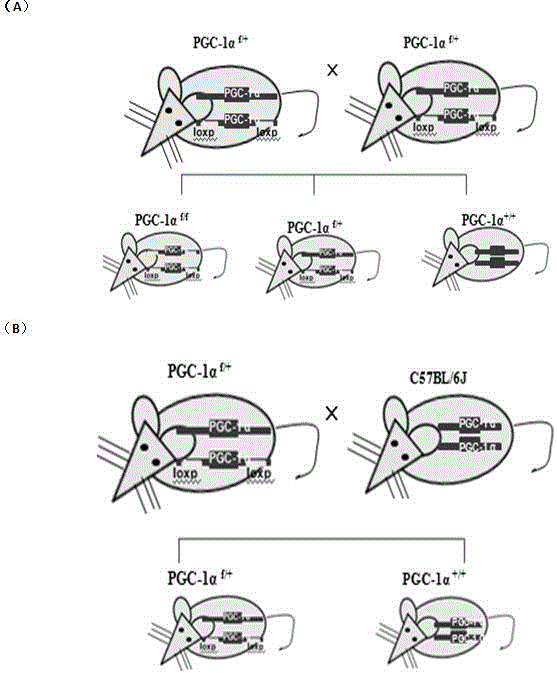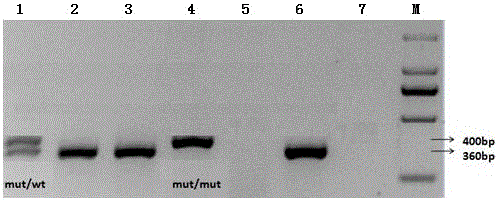GABAergic neuron conditional knockout gene PGC-1 alpha mouse model and construction method thereof
A PGC-1 and mouse model technology, applied in biochemical equipment and methods, microbe measurement/inspection, animal husbandry, etc., can solve the problems of decreased survival rate and obstruction, and achieve the effect of avoiding the decline of survival rate
- Summary
- Abstract
- Description
- Claims
- Application Information
AI Technical Summary
Problems solved by technology
Method used
Image
Examples
Embodiment 1
[0040] Example 1: Introduction and Breeding of Conditional Gene Knockout Mice
[0041] 1.1 Experimental animals
[0042] PGC-1α flox / + Conditional knockout mouse, strain name B6.129-Ppargc1α tm2Brsp / JNju , purchased from JacksonLab, USA, 2 males and 2 males. Dlx5 / 6 Cre-IRES-EGFP Donated by Professor Zhao Chunjie of Southeast University, two males and two males, the mice express Cre recombinase in GABAegic interneurons; Dlx5 / 6 Cre-IRES-EGFP The transgenic mice were transformed into a 0.5kb fragment containing id6 / id5 enhancer, Beta-globin enhancer and enhanced green fluorescent fusion protein EGFP (Enhanced green fluorescent fusion protein). SPF-grade C57BL / 6J mice were purchased from the Experimental Animal Center of Jiangsu University [permit number: SCxk (Su) 2015-0001].
[0043] alpha flox / + Feeding of mice
[0044] PGC-1α flox / + The mice were fed in accordance with the SPF animal feeding standards. After isolation and observation, no abnormalities were found, they ...
Embodiment 2
[0045] Example 2: PGC-1α flox / + Mouse identification, population expansion and conservation
[0046] 2.1 Extraction of genomic DNA from PGC-1α conditional knockout mice
[0047] Male and female mice purchased from JacksonLab in the United States were mated, and the offspring were numbered by cutting off the toes (cutting out the toes of offspring 5-6 days after birth), numbering from hind limbs to forelimbs, and from right to left. Clipped toe tissue was used to extract genomic DNA. The general steps of genomic DNA extraction are as follows: (1) Take mouse toes (according to the order of 1-10) and put them into 1.5mLEP tubes, and centrifuge them for 30s to make them sink to the bottom of the tubes. (2) Add 30μL lysate (0.5%20%Tween-20, 1MKCL50mM, 1MMgCl 2 15mM, 1MTris-HCl2.5mM, pH8.0, add 200μg / mL proteinase K before use (3μL), (3) digest at 55°C for 3-5h, centrifuge at 12,000rpm for 2min, 95°C, 15min, inactivate proteinase K, centrifuge at 12,000rpm After 2 minutes, the D...
Embodiment 3
[0060] Example 3: Dlx5 / 6 Cre-IRES-EGFP Mouse genotyping and amplification
[0061] Dlx5 / 6 Cre-IRES-EGFP The mice were transformed into a 0.5kb fragment containing id6 / id5 enhancer, Beta-globin enhancer and enhanced green fluorescent fusion protein EGFP (Enhanced green fluorescent fusion protein). Dlx5 / 6 Cre-IRES-EGFP The offspring obtained after mating mice with C57BL / 6J mice theoretically include Dlx5 / 6 Cre-IRES-EGFP Transgenic mice and wild-type mice.
[0062] For transgenic mice specifically expressing Cre recombinase in GABAergic interneurons, because EGFP was transferred, the pups were placed on a fluorescent microscope 1-2 days after birth, and excited by blue light, small cells could be seen through the skull. Whether the Cre recombinase is transferred into the mouse brain (the green fluorescent protein can be seen after the transfer), such as Figure 4 as shown, Figure 4 It can be seen in Figures A, B, and C that green fluorescence appears, indicating that these...
PUM
 Login to View More
Login to View More Abstract
Description
Claims
Application Information
 Login to View More
Login to View More - R&D
- Intellectual Property
- Life Sciences
- Materials
- Tech Scout
- Unparalleled Data Quality
- Higher Quality Content
- 60% Fewer Hallucinations
Browse by: Latest US Patents, China's latest patents, Technical Efficacy Thesaurus, Application Domain, Technology Topic, Popular Technical Reports.
© 2025 PatSnap. All rights reserved.Legal|Privacy policy|Modern Slavery Act Transparency Statement|Sitemap|About US| Contact US: help@patsnap.com



